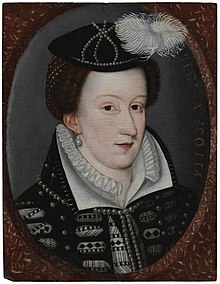Ralph Lygon
Ralph Liggons or Lygon (1540-1619) was an English Catholic involved in conspiracies and a supporter of Mary, Queen of Scots.[1]
Family background[edit]
He was a member of the Worcestershire Lygon family, a son of William Lygon (died 1567) and his wife Eleanor Denys. His brother Richard (died 1584) was head of the family, based at Madresfield Court, his brother Roger Lygon was a Gentleman Usher to Mary I,[2] and his nephew William Lygon was a Member of Parliament.[3] Several contemporary records include his surname written as "Liggons" or "Ligons". These spelling are preferred by historians.
Career[edit]

Ralph Liggons attended the baptism of James VI at Stirling Castle in December 1566. Mary, Queen of Scots gave him a gold chain.[4] He was involved in the Rising of the North in 1569, and plotted with Thomas Howard, 4th Duke of Norfolk and Mary, Queen of Scots. He received a pension from Philip II of Spain. Mary's secretary Claude Nau sent him a cipher code to use in correspondence in January 1577.[5]
He was an exile in Brussels and Paris after the revealing of the Ridolfi Plot.[6] Mary, Queen of Scots also left him a pension in her will.[7]
Liggons was involved in the 1605 Gunpowder Plot.
References[edit]
- ^ Katy Gibbons, English Catholic Exiles in Late Sixteenth-century Paris (Boydell, 2011), p. 155.
- ^ David Loades, Mary Tudor (Basil Blackwell, 1989), p. 191.
- ^ William Lygon Beauchamp, Madresfield Muniments (1929), p. 25.
- ^ Thomas Thomson, James Melville: Memoirs of his own life (Edinburgh, 1827), p. 172 as "Lignish": Tracey Sowerby, 'A Memorial and a Pledge of Faith': Portraiture and Early Modern Diplomatic Culture', English Historical Review, 129:537 (April 2014), p. 317.
- ^ William Barclay Turnbull, Letters of Mary Stuart (London, 1845), p. 251.
- ^ Katy Gibbons, English Catholic Exiles in Late Sixteenth-century Paris (Boydell, 2011), p. 29.
- ^ Teulet, vol. 5, p. 503.
